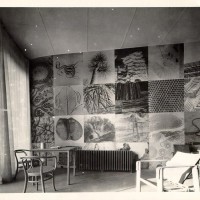
EL MURAL FOTOGRÁFICO DEL PABELLÓN SUIZO: LA CUADRÍCULA DE CONFLUENCIAS
Estado:
Autor:
Director/es:
Tutor:
El pabellón Suizo de 1933 diseñado y llevado a cabo por Le Corbusier y Pierre Jeanneret. Era edificio destinado a alojar estudiantes universitarios. En la planta baja se encuentran los espacios comunes y en el resto de alturas las habitaciones. Es un inmueble de vida en común donde el comedor tendrá una gran importancia como lugar de encuentro. Es en este comedor, en su muro curvo donde Le Corbusier recibe el encargo de imaginar algún tipo de decoración que represente los paisajes y el espíritu suizos. Al ser un muro curvo resultaba imposible colgar un cuadro de gran tamaño. Por otro lado había que hacer algo muy rápidamente porque la fecha de la inauguración estaba muy cerca.
“J’eus alors l’idée de réaliser, en deux ou trois jours, le premier “mural photographique” dice Le Corbusier en una entrevista años mas tarde. Le Corbusier decide realizar un mural en tres días. El mural estará compuesto de 40 fragmentos para adecuarse a la curva del muro. Estos fragmentos serán fotografías ampliadas y tomadas con anterioridad por Le Corbusier, Pierre Jeanneret y Charlotte Perriand. Le Corbusier considera el conjunto como una “sinfonía” de la cual es el «jefe de orquesta”. El resultado es un conjunto heterogéneo de fotografías de paisajes, de fragmentos de objetos de la naturaleza y de visiones a través del microscopio.
Le Corbusier fue muy pronto consciente del relevante papel que iba a adquirir la fotografía en la cultura visual de los hombres del siglo XX. Son conocidas una ingente cantidad de fotografías ya desde sus primeros periplos de juventud, sea el viaje a Italia o, muy especialmente, su Voyage d’Orient, de donde regresó con casi 500 fotografías de los lugares, esculturas y objetos de arte decorativo, paisajes, personas o edificios que conoció y fueron fuente de su aprendizaje.
El mural fotográfico del pabellón Suizo aparece como un catálogo de 11×4 fotografías desordenadas donde están representados múltiples objetos y paisajes a muy diferentes escalas. Estudiando con detenimiento esta obra, podemos distinguir fotografías que parecen poder agruparse siguiendo diferentes temáticas como pueden ser los árboles, los paisajes o la biología. Estas temáticas han sido elegidas por Le Corbusier y por tanto son el reflejo de su pensamiento. El mismo dirá años mas tarde en una entrevista: “C’était l’explosion de chocs que je ressentais depuis longtemps“. No sería pues descabellado pensar que las temáticas presentes en el mural lo estén también en el resto de la obra de le Corbusier, tanto en la arquitectura como en la pintura.


